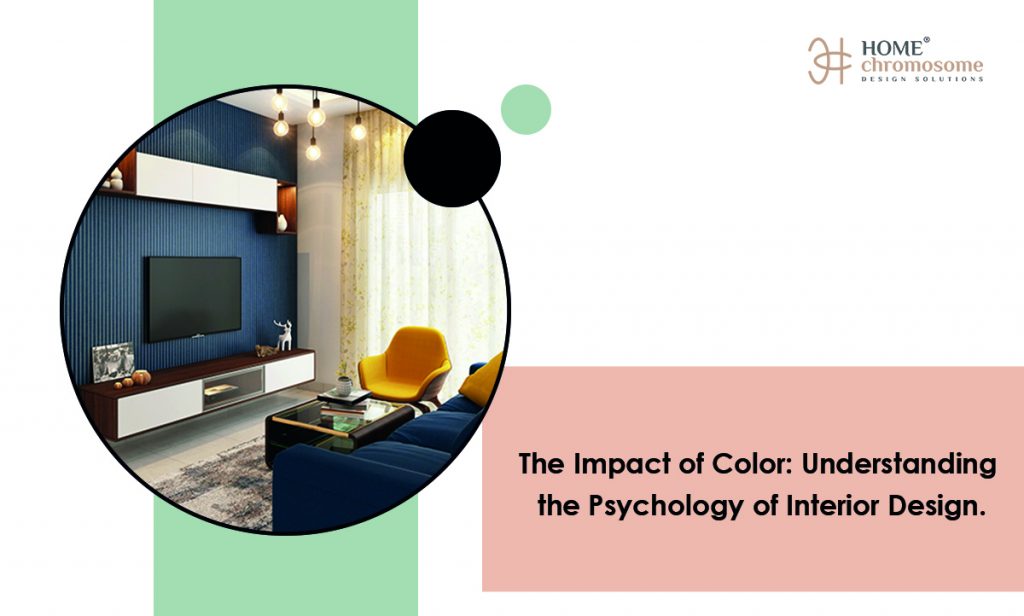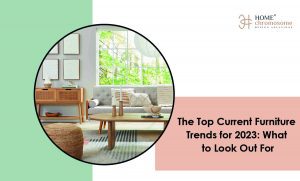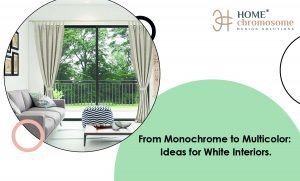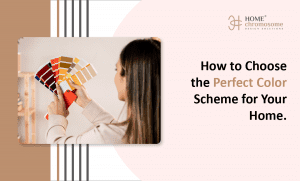Interior designing – When it comes to designing the interior of your home, it’s easy to get caught up in the latest trends and aesthetics. However, there’s more to interior design than just following the crowd. The colors you choose for your walls, furniture, and decor can have a profound impact on your mood, emotions, and overall well-being. In this blog, we’ll delve into the fascinating world of color psychology and explore how different colors can influence the atmosphere and ambiance of your living space.

The Basics of Color Psychology in interior designing
Before we dive into the impact of specific colors, let’s understand the basics of color psychology. Color psychology is the study of how different colors can affect human behavior, emotions, and perceptions. This field of study has been widely applied in various disciplines, including marketing, branding, and, of course, interior design.
Colors are not just visually appealing; they have the power to evoke specific feelings and emotions. Designers and psychologists have long recognized that the right color choices can create a harmonious and inviting atmosphere, while the wrong choices can lead to discomfort and unease.
Warm vs. Cool Colors in Interior designing
One of the fundamental concepts in color psychology is the division of colors into warm and cool categories. Warm colors, such as reds, oranges, and yellows, are associated with energy, warmth, and vibrancy. They can stimulate and excite the senses, making them ideal for spaces where you want to encourage social interaction and activity. However, too much of these colors can be overwhelming.
Cool colors, like blues, greens, and purples, evoke a sense of calm, tranquility, and relaxation. They are excellent choices for creating peaceful and serene environments, such as bedrooms and bathrooms. However, excessive use of cool colors can make a space feel chilly or unwelcoming.
The Impact of Specific Colors in interior designing
Now, let’s explore the impact of specific colors and how you can use them effectively in your interior design:
- Red: This bold and passionate color is known to increase energy levels and stimulate conversation. It’s perfect for dining rooms or living spaces where you want to create a lively and sociable atmosphere.
- Green: Symbolizing nature and growth, green is a versatile color that can work in almost any room. It promotes a sense of balance and harmony, making it suitable for bedrooms, living rooms, and home offices.
- Yellow: Cheerful and uplifting, yellow can add a burst of energy to kitchens and dining areas. However, use it sparingly as too much yellow can be overwhelming.
- Purple: Associated with luxury and creativity, purple is an excellent choice for bedrooms or home offices. Light purples convey a sense of tranquility, while deep purples exude opulence.
- Neutral Colors: White, gray, and beige are often used as neutral backgrounds in interior design. They provide a blank canvas that allows other colors to shine. Neutrals create a sense of simplicity and sophistication and are suitable for any room.
Personal Preferences Matter in Interior designing
While color psychology offers valuable insights, it’s essential to remember that individual preferences play a significant role in interior design. What one person finds soothing, another might find dull. When designing your space, consider your personal tastes and the specific mood you want to create.
Creating Balance with Complementary Colors in Interior designing
Complementary colors are pairs of colors that are opposite each other on the color wheel, such as red and green or blue and orange. When used strategically, these colors can create a vibrant and visually appealing contrast in your interior design. For example, using pops of complementary colors in accents like throw pillows, artwork, or decor can make a space feel dynamic and energetic.
Monochromatic Schemes for Elegance in Interior designing
A monochromatic color scheme involves using varying shades and tints of a single color. This approach can result in a sophisticated and harmonious ambiance. For instance, a monochromatic blue living room with different shades of blue on the walls, furniture, and decor can create a calming and stylish atmosphere.
Bold Accents and Focal Points in Interior designing
If you’re hesitant about using bold colors throughout a room, consider incorporating them as accents or focal points. A red statement wall in an otherwise neutral room can draw attention and create a striking visual impact without overwhelming the space.
Transitioning Colors in Open Spaces in Interior designing
In open-concept living areas, using a gradual transition of colors can define different zones while maintaining a cohesive look. For example, starting with a soft blue in the living room and gradually transitioning to a deeper blue in the dining area can create a seamless flow while adding depth to the space.
Nature-Inspired Color Palettes in Interior designing
Nature provides a rich source of color inspiration. Earthy tones such as browns, greens, and warm neutrals can evoke a sense of comfort and connection to the outdoors. Integrating natural textures like wooden furniture or stone accents can enhance the effect and create a calming environment.
Cultural and Historical Significance in Interior designing
Colors often have cultural or historical significance that can add depth and meaning to your interior design. For instance, deep reds and golds in an Asian-inspired decor can evoke a sense of luxury and tradition, while muted pastels might bring to mind a vintage or shabby-chic aesthetic.
Lighting and Color Interaction in Interior designing
Keep in mind that lighting can significantly influence how colors appear in a space. Natural light, incandescent bulbs, and LED lighting can all affect the perceived color. Be sure to test your color choices under different lighting conditions to ensure they have the desired effect.
Personal Expression Through Color in Interior designing
Your home is a reflection of your personality and style, so don’t be afraid to infuse it with colors that resonate with you personally. If a color brings back positive memories or emotions, consider incorporating it into your design, even if it’s not part of the traditional color psychology guidelines.
Experimentation and Adaptation in Interior designing
Color preferences can change over time, so don’t be afraid to experiment and adapt your color choices as your tastes evolve. Paint is one of the easiest design elements to change, so if you’re unsure about committing to a bold color, start with smaller accents and see how you feel before making a larger commitment.
To Conclude…
The psychology of color is a powerful tool in interior design, offering a nuanced way to shape the ambiance and atmosphere of your living spaces. By considering complementary colors, monochromatic schemes, bold accents, and the interaction between color and lighting, you can create a truly unique and engaging environment that aligns with your personal preferences and the emotions you want to evoke. Remember, there are no strict rules in color selection—trust your instincts and have fun bringing your space to life with the magic of color.







